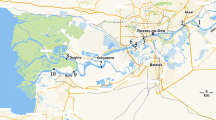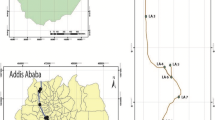Abstract
Cu, Zn, Cd and Pb have been analysed in suspendedmatter and water samples from the Scheldt estuary,collected during five cruises between May 1982 and May1983. In order to evaluate the overall metal behaviourin the estuary, continuous longitudinal profiles ofthe total, the particulate and the dissolved metalconcentrations are discussed in relation to variousspecific physico-chemical parameters. By means ofcorrelation and multi-regression techniques, severalestuarine processes could be identified which dominateand/or control the behaviour of the individual tracemetals in three distinct areas of the Scheldt estuary.
The behaviour of the four selected metals was foundto show some common features, but is besides this alsocharacterised by many individual and specificproperties. The total metal concentrations seem toco-vary well with the turbidity in the maximumturbidity zone between salinities 2 and 10 psu. In thedownstream area a dilution profile is observed for thetotal metal concentrations of Cu and Cd as well as forthe dissolved concentrations of all metals.
Dissolved metal production rates are high for Cu andCd, but much lower for Zn and Pb, confirming thedifferent longitudinal dissolved metal profiles. ForCu and Cd these dissolved metal profiles arecharacterised by a broad mobilisation area, coveringthe whole middle estuary. Pb on the other hand, showsa more confined mobilisation area, and for Zn no sucharea was found. During winter the dissolved metalproduction rates seem to be controlled, predominantly,by desorption processes. During summer dissolved metalproduction is correlated mainly to the dissolvedoxygen content, suggesting the domination of redoxprocesses solely or in combination with desorptionprocesses. In some cases, co-existent with nearly zerooxygen concentrations, removal of dissolved metals wasobserved, possibly reflecting precipitation reactions.
Longitudinal particulate metal profiles all show anegative deviation versus the dilution profile. Cu andCd provide the higher deviations, characterised by anarrow enrichment zone preceding a broad mobilisationarea. Finally, all particulate metal profiles appearedto correlate well with POC, when expressed involumetric units.
Similar content being viewed by others
References
Baeyens, W. & F. Monteny, 1988. Study of the degree of contamination of dredge in the Scheldt estuary. Synthesis Report. VUB, Brussels, pp 53.
Baeyens, W., 1992. Speciation ofmercury in different compartments of the environment. Trends in analytical chemistry, 11: 245–254.
Baeyens, W., S. Panutrakul, M. Elskens, M. Leermakers, J. Navez & F. Monteny, 1991. Geochemical Processes in Muddy and Sandy Tidal Flat Sediments. Geo-Marine Lett. 11: 188–193.
Baeyens, W., 1998. Evolution of trace metal concentrations in the Scheldt estuary (1978–1995). A comparison with other estuaries and background ocean levels. Hydrobiologia 366: 157–167.
Baeyens, W., L. Goeyens, F. Monteny & M. Elskens, 1998a. Effect of organic complexation on the behaviour of dissolved Cd, Cu and Zn in the Scheldt estuary. Hydrobiologia 366: 81–90.
Baeyens, W., F. Monteny, R. Van Ryssen & M. Leermakers, 1998b. A box-model of metal flows through the scheldt estuary (1981–1983 and 1992–1995). Hydrobiologia 366: 109–128.
Baeyens, W., K. Parmentier, L. Goeyens, G. Ducastel, M. De Gieter & M. Leermakers, 1998c. The biogeochemical behaviour of Cd, Cu, Pb and Zn in the Scheldt estuary: results of the 1995 surveys. Hydrobiologia 366: 45–62.
Baeyens, W., G. T. M. Van Eck, C. Lambert, R. Wollast & L. Goeyens, 1998d. General description of the Scheldt estuary. Hydrobiologia 366: 1–14.
Baeyens, W., M. Elskens, R. Van Ryssen & M. Leermakers, 1998e. The impact of the Scheldt input on the trace metal distribution in the Belgian coastal area (results of 1981–1983 and 1995–1996). Hydrobiologia 366: 91–108.
Balls, P. W., 1989. The partition of trace metals between dissolved and particulate phases in European coastal waters: a compilation of field data and comparison with laboratory studies. Neth. J. Sea Res. 23: 7–14.
Batley, G. E. & D. Gardner, 1977. Sampling and storage of natural waters for trace metal analysis. Wat. Res. 1: 745–756.
Benjamin, M. M. & J. O. Leckie, 1981. Multiple-site adsorption of Cd, Cu, Zn and Pb on amorphous iron. O. J. Coll. Interface Sci. 79: 209–221.
Benoit, G., S. D. Oktay-Marshall, A. Cantu, E. M. Hood, C. H. Coleman, M. O. Corapeioghi & P. H. Santschi, 1994. Partitioning of Cu, Pb, Ag, Zn, Fe, Al and Mn between filter-retained particles, colloids and solution in six Texas estuaries. Mar. Chem. 45: 307–336.
Boulègue, J., 1978. Metastable sulfur species and trace metals in hot brines from the French Dogger. Am. J. Sci. 278: 1394.
Duinker, J. C., R. F. Nolting & D. Michel, 1982. Effects of salinity, pH and redox conditions on the behaviour of Cd, Zn, Ni an Mn in the Scheldt Estuary. Thalassia Yugoslavia 18: 191–202.
Elskens, M., M. Leermakers, S. Panatrakul, F. Monteny & W. Baeyens, 1991. Microbial Activity in Sandy and Muddy Estuarine Sediments. Geo-Marine Lett. 11: 194–198.
Emerson, S., L. Jacobs & B. Lebo, 1983. The behaviour of heavy metals in marine anoxic water: Solubilities at the oxygenhydrogen sulfide interface. In C. S. Wong, E. Boyle, K. W. Bruland, J. D. Eurton & E. D. Goldberg (eds), Trace Metals in Sea Water, Plenum Press, New York, 579–608.
Gillain, G., G. Duyckaerts & A. Distèche., 1979. The determination of trace metals in sea water and suspended matter by classical anodic stripping (Zn, Cd, Pb and Cu) or differential pulse anodic stripping voltammetry with a hanging mercury drop electrode (Zn, Cd, Pb, Cu, Sb and Bi)–An approach to speciation. In Geconcerteerde Onderzoeksacties Oceanologie, Ministerie voor de Programmatie van het Wetenschapsbeleid, Brussels: 123–131.
Gillain, G. & C. Brihaye, 1985. A system for taking a representative sample form a large volume of turbid surface sea water for trace element determinations. Analyt. chim. Acta 167: 387–391.
Jouaneau, J. M., H. Etcheber & C. Latouche, 1983. Impoverishment and decrease of metallic elements associated with suspended matter in the Gironde estuary. In C. S. Wong, E. Boyle, K.W. Bruland, J. D. Eurton & E. D. Goldberg (eds), Trace Metals in Sea Water, Plenum Press, New York: 245–264.
Mantoura, R. F. C., A. Dickson & J. P. Riley, 1978. The complexation of metals with bunic materials in natural waters. Estuar. coast. mar. Sci. 6: 387–408.
Mart, L., 1979. Prevention of contamination and other occurring risks in voltammetric trace metal analysis of natural waters. I. Preparatory steps of filtration and storage of water samples. Fresenius Z. Anal. Chem. 296: 350–355.
Nolting, R. F., 1986. Copper, zinc, cadmium, nickel, iron and manganese in the Southern Bight of the North Sea. Mar. Pollut. Bull. 17: 113–117.
Panutrakul, S. & W. Baeyens, 1991. Behaviour of heavy metals in a mud flat of the Scheldt Estuary, Belgium. Mar. Pollut. Bull. 22: 128–134.
Valenta, P., E. K. Duursma, A. G. A. Merks, H. Rutzel & H. W. Nurnberg, 1986. Distribution of Cd, Pb, Cu between the dissolved phase and the particulate phase in the Eastern Scheldt and the Western Scheldt Estuary. Sci. tot. Envir. 53: 41–76.
Van Den Berg, C. M. G., A. G. A. Merks & E. K. Duursma, 1987. Organic complexation and its control of the dissolved concentrations of Cu and Zn in the Scheldt Estuary. Estuar. coast. Shelf Sci. 24: 785–797.
Zwolsman, J. J. G. & G. T. M. Van Eck, 1991. The behaviour of dissolved Cd, Cu and Zn in the Scheldt Estuary, Estuar. water Qual. Mgmt. Springer-Verlag, Berlin: 413–420.
Author information
Authors and Affiliations
Rights and permissions
About this article
Cite this article
Baeyens, W., Elskens, M., Gillain, G. et al. Biogeochemical behaviour of Cd, Cu, Pb and Zn in the Scheldt estuary during the period 1981–1983. Hydrobiologia 366, 15–44 (1997). https://doi.org/10.1023/A:1003168125869
Issue Date:
DOI: https://doi.org/10.1023/A:1003168125869




